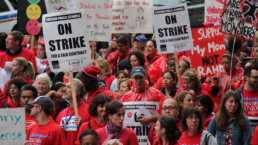The United States is notorious for having the weakest welfare state of any advanced economy. The labor movement needs to fight for social provisions for all workers, not just some.
Maya Adereth, Jacobin
Welfare provision in the United States is notoriously weak. With no coordinated wage setting and an amalgamation of haphazard, minimal, and means-tested benefits, American workers are for the most part left to fend for themselves against soaring levels of inequality and plummeting standards of living. Among advanced economies, American workers fare much worse than their counterparts. How did it come to be this way?
In part, the fragility of the American welfare system can be attributed to the systematic enfeeblement of its labor movement. Throughout its history, the movement has faced coordinated attacks by employers, often in collaboration with the state, and the near-total exclusion of labor from the policymaking sphere. But this weakness can also be traced to its early strategic orientation. While labor movements in France, Germany, and the UK developed an industrial unionism that unified skilled craft workers with general laborers, the American labor movement preserved a craft model that prioritized the mobilization of skilled white male workers above all others.

These diverging strategies had significant implications: whereas trade unions in many European countries came to advance universal systems of welfare benefits, American unions, under the leadership of the American Federation of Labor (AFL), advocated sectional benefits exclusive to their organized workers. Hostile to immigrants and the “unskilled,” AFL leaders like Samuel Gompers went so far as to campaign against measures like compulsory health care throughout the Progressive Era.
Recent Posts
‘Unconstitutional. Unethical. Authoritarian.’ ICE Bars Millions Of Immigrants From Bond Hearings
July 18, 2025
Take Action Now One watchdog said the new policy “seems like a blatant attempt to stop them from exercising their right to due process.”……
Americans Are Not Nearly Alarmed Enough About Climate Change
July 18, 2025
Take Action Now Americans still don’t comprehend how imminent, dangerous, and far-reaching the threat is—and journalists are partly to blame.By…
The IRS Is Building A Vast System To Share Millions Of Taxpayers’ Data With ICE
July 17, 2025
Take Action Now ProPublica has obtained the blueprint for the Trump administration’s unprecedented plan to turn over IRS records to Homeland Security…
Israel’s Sudden Assault On Syria Is Unchecked Aggression
July 17, 2025
Take Action Now Jerusalem is bombing Damascus and threatening al-Sharaa’s rule, while Washington was hoping to help the nascent government on…




